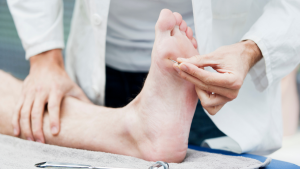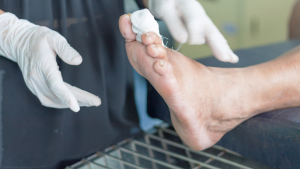Diabetes is one of the most prevalent medical conditions in the United States, and also one of the most expensive: The Centers for Disease Control estimates that $1 out of every $4 spent on health care is for diabetes.
Table of Contents
The High Costs of Diabetic Foot Complications
The cost of diabetes care can rise exponentially if the disease leads to complications involving the feet. Consider these statistics:
- Diabetes care for a patient without foot ulcers costs about $17,000 a year.
- Care for a patient with diabetes-related ulcers on the foot costs about $58,000 a year.
- Untreated or inadequately treated diabetes complications can lead to lower-limb amputation, which costs $100,000 for the procedure alone, before ongoing annual costs of about $52,000.
 It’s National Diabetes Awareness Month, and a good time for Ankle & Foot Centers of America to remind patients in Columbus, GA, and surrounding communities of our commitment to providing diabetes patients with care that prevents those costs – and far more importantly, care that allows people to remain active, mobile, and maintain their quality of life.
It’s National Diabetes Awareness Month, and a good time for Ankle & Foot Centers of America to remind patients in Columbus, GA, and surrounding communities of our commitment to providing diabetes patients with care that prevents those costs – and far more importantly, care that allows people to remain active, mobile, and maintain their quality of life.
Ankle & Foot Centers of America has been providing patients with the most effective and innovative care for more than three decades. One example is our advanced vascular services that address the risks of diabetes to the lower extremities.
Preventing Ulcers on the Foot with Advanced Care
Complications like a diabetic ulcer on the foot and infections are often exacerbated by peripheral arterial disease (PAD), a condition that restricts blood flow to the lower extremities. Vascular care plays a critical role in improving circulation to the feet and lower limbs, because enhanced blood flow significantly reduces the risk of infection, ulcers, and amputation. Our diabetes care also includes specialized teams in Columbus, GA, ready to assist with preventive care, wound management, and vascular assessments.
In combination, our care services improve blood flow and support limb preservation, helping patients manage their condition and maintain mobility. “Our expanded capabilities in vascular care allow us to address the root issues of diabetic foot complications,” says Dr. Joseph Giovinco, CEO of Ankle & Foot Centers of America and a board-certified podiatrist. “With this approach, we’ll help protect our patients’ mobility and prevent serious outcomes, like amputations, while delivering the highest level of personalized care.”

FAQ: Diabetic Foot Ulcers
What does a diabetic foot ulcer look like?
A diabetic foot ulcer often appears as an open sore or wound on the foot, commonly on the bottom or pressure points like the toes or heel. Early signs may include redness, swelling, or a small blister that does not heal. The surrounding skin may appear discolored or have a foul odor if an infection develops.
What is an early stage diabetic foot ulcer?
 In the early stages, a diabetic foot ulcer may look like a small red area, blister, or shallow wound. It may not cause significant pain due to diabetic nerve damage. Catching ulcers at this stage is critical for preventing infection and promoting faster healing.
In the early stages, a diabetic foot ulcer may look like a small red area, blister, or shallow wound. It may not cause significant pain due to diabetic nerve damage. Catching ulcers at this stage is critical for preventing infection and promoting faster healing.
What causes a foot ulcer?
Foot ulcers are caused by a combination of factors, including poor circulation, high blood sugar levels, and pressure or friction on the foot. Diabetic neuropathy (nerve damage) reduces the ability to feel pain or discomfort, which can lead to unnoticed injuries that progress to ulcers.
How is a diabetic foot ulcer treated?
Treatment for diabetic foot ulcers involves cleaning the wound, removing dead tissue (debridement), and applying dressings to promote healing. Advanced treatments may include specialized wound care products, hyperbaric oxygen therapy, and surgical intervention if needed. Managing blood sugar levels and reducing pressure on the ulcer with custom footwear or orthotics are essential components of treatment.
How can a diabetic wound heal faster?
To promote faster healing of a diabetic wound:
- Keep blood sugar levels under control.
- Maintain proper wound hygiene and change dressings regularly.
- Follow your podiatrist’s advice for pressure relief with specialized footwear or offloading devices.
- Seek advanced care, such as vascular treatments, to improve blood flow to the area.
- Address infections promptly with antibiotics, if prescribed.
To learn more about our specialized care for diabetic foot complications, including services that prevent and treat ulcers on the foot, or our entire scope of care from education to diagnosis to routine and advanced surgery and rehabilitation, please visit Ankle & Foot Centers of America.






